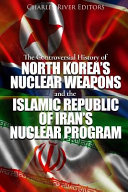
The Controversial History of North Korea's Nuclear Weapons and the Islamic Republic of Iran's Nuclear Program PDF
90 Pages·2017·1.6221 MB·other
Most books are stored in the elastic cloud where traffic is expensive. For this reason, we have a limit on daily download.
Preview The Controversial History of North Korea's Nuclear Weapons and the Islamic Republic of Iran's Nuclear Program
Description:
*Includes pictures *Includes online resources and a bibliography for further reading North Korea has long been the butt of jokes, and it has been a longstanding target of international criticism, but the startling satellite image was anything but amusing, for it demonstrated the truly catastrophic conditions North Koreans find themselves in. Statistics show that the average South Korean uses up to 10,162 kilowatt hours of power per year, whereas their neighbors in the north consume only 739. This is only one amongst a slew of stumbling blocks affecting the state, impeding it from proper progress. North Korea would be horrific enough if it was a fictional place, but its nuclear weapons program is all too real. On September 17, 2017, President Donald Trump, whose use of Twitter may be what he's best known for, tweeted another nickname of the type he has infamously coined for his opponents: "I spoke with President Moon of South Korea last night. Asked him how Rocket Man is doing. Long gas lines forming in North Korea. Too bad!" The "Rocket Man" in question, of course, was none other than the notoriously brutal and wildly erratic North Korean dictator, Kim Jong-Un. In less than 24 hours, the viral tweet had not only racked up tens of thousands of retweets and triple the "likes," it had spawned countless Elton John-themed memes and inspired headlines from just about every news source around the world. Capitalizing on the viral nature of the controversial tweet, Trump repeated the nickname just a few days later in his speech before the UN General Assembly. He warned the congregation of fidgety ambassadors about the grave threats posed by North Korea's "depraved regime." "The United States had great strength and patience, but if forced to defend itself or its allies, we will have no choice but to totally destroy North Korea...Rocket Man is on a suicide mission for himself and for his regime." Needless to say, the rumors regarding Iran's nuclear capabilities and the murky nature of the regime have understandably left many a nation and their leaders on the edge of their seats. The volatile nation's deep-seated loathing of the West, particularly the United States and Israel, have only added to the jitters worldwide. Experts insist that the Iranian propaganda program, which many say outrival even North Korea's, is chiefly responsible for entrenching into its masses this resentment of the West and their liberal ideals. For starters, Iranians are taught that the Armed Forces of the Islamic Republic of Iran, untouchable in the government's eyes, deserve their utmost respect and gratitude, as these are the intrepid warriors defending their country from the ceaseless threats of the Western infidels. Unlike North Korea, which proudly walls itself off from the rest of civilization, the Iranian propaganda mills are constantly refurbishing themselves so as to appeal to a younger and more impressionable demographic. Since the Iranian Revolution, Western nations and their intelligence agencies have struggled to fully grasp what goes on in Iran, and it has resulted in a situation that reads like a spy thriller. The last decade has featured the assassinations of Iranian nuclear scientists, the use of sophisticated cyberattacks like Stuxnet, the construction of a hidden enrichment facility underneath a mountain, ongoing arguments over the nature of Iran's nuclear program, efforts to determine whether there was potential procurement and testing of materials that would be used in nuclear weapons, debates over ballistic missiles, and a 2015 agreement between Iran and several world powers that remains a controversial issue to this day. There is even substantial concern that Iran and North Korea are jointly working on their nuclear programs, with Iranian scientists witnessing North Korean nuclear weapons tests and North Korean scientists in Iran overseeing research and development.
See more
The list of books you might like
Most books are stored in the elastic cloud where traffic is expensive. For this reason, we have a limit on daily download.
